Why facial eczema is a year-round problem
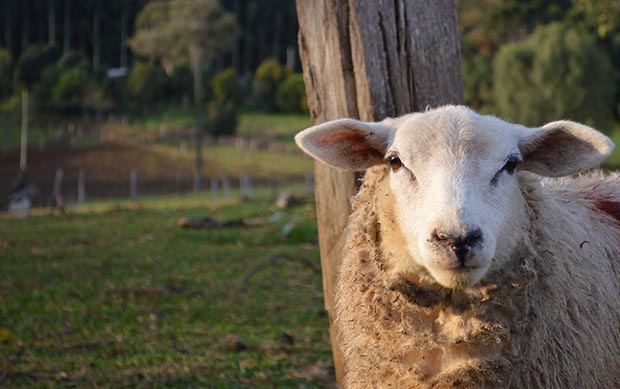
Each summer we remind you to get extra zinc into your livestock to help prevent the liver damage caused by facial eczema, but FE is actually a problem you need to be thinking about all year round.
Words: Dr Clive Dalton
As the climate changes, experts are predicting FE disease will start to appear in new areas – that means you, South Islanders.
What is FE?
Facial eczema is caused by a toxin (sporisdesim) produced by the spores of the fungus Pithomyces chartarum. The fungus grows in the dead litter at the base of pasture most of the year but becomes a problem when spore numbers skyrocket in warm, moist conditions. It currently affects the North Island and top of the South Island but climate change may see it affect livestock further south.
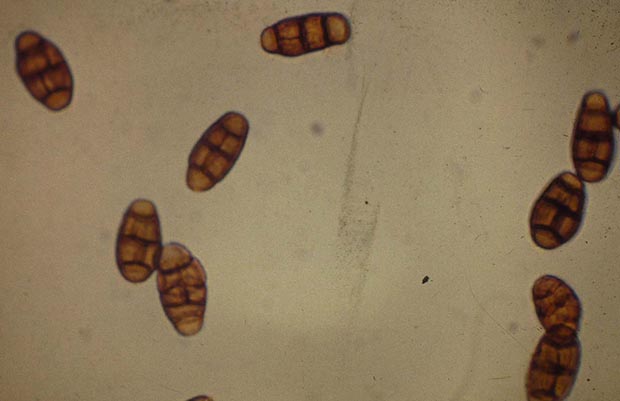
The spores that cause facial eczema, as seen under a microscope, look like little hand grenades. Active spores are brown, if they are black they are old and harmless
Find out the spore count in your area – February is when spore populations explode and start to cause serious health issues.
FE damages the liver and bile ducts of sheep, cattle and alpaca (to a lesser degree in goats), causing a drop in milk production in cattle, and irritation to the skin which becomes thick, itchy and peeling. Badly-affected animals will die, often when their body comes under pressure such as during pregnancy and lactation or during cold winters or drought conditions. Animals that survive are less productive and don’t live as long as unaffected animals.
FE mysteriously affects NZ, but nowhere else
In the late 1930s, facial eczema was decimating sheep flocks in the greater Waikato, with farmers regularly losing 1000 sheep each year, especially hoggets. The dry coastal hill country from Port Waikato down to Raglan was especially hard hit.
Things got so bad that Federated Farmers demanded researchers to find the cause and a cure. The government responded and Dr CP McMeekan moved from Massey College to start a new Animal Research Station at Ruakura.
The answer would take 30 long years to find. The breakthrough came when the groundsman at Claudelands in Hamilton noticed black dust on his boots when mowing the grass. That dust turned out to be the fungal spores of Pithomyces chartarum which was shown to produce the toxin sporidesmin.
Few could believe that a fungus could be the cause, when so much time and money was spent investigating all sorts of other daft suggestions and quack cures which MAF was committed to testing.
This fungus is present in other countries, but the spores are not toxic anywhere else. Why they are so damaging in NZ conditions has never been explained.
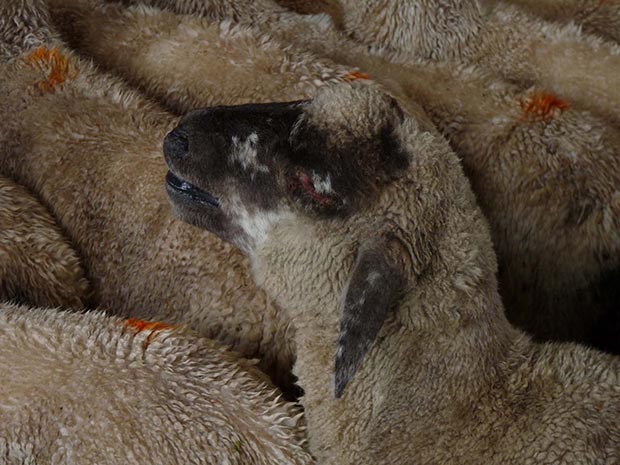
Earlier clinical signs include drooping ears and red eyes (from itching).
The zinc wars
A lot of energy was wasted by Ruakura scientists arguing with Te Aroha farmer and former dental nurse, Gladys Reid. She discovered zinc was the best prevention for the liver damage caused by FE back in the late 1940s, thanks to her work in the dental industry and years of research. Gladys would throw zinc salts into farm water troughs, even testing her livestock by dosing some and not others to check her (correct) hypothesis.
While farmers in NZ and the USA followed her lead and raved about her work, the Ruakura team never liked it. The pointless argument over who was first to ‘discover zinc’ went on for 30 years. Before Gladys died in her 90s in 2006, I got her to put a collection of her papers in the Hamilton City Library archive. Gladys always believed that she was awarded her OBE to placate her over the way MAF had treated her.
Getting the zinc down the throat
What Ruakura did do was isolate the best zinc dose rates. This was very important work as too much zinc can be toxic and damages the rumen.
Zinc oxide was used as a drench, which was easy for dairy farmers as cows almost opened their mouths when they saw the drench gun. But it was a disaster for sheep farmers who had to mix the powder and water in the woolshed (an old washing machine was good) and dose them twice a week. Staff and equipment would would end up coated in the stuff.
Zinc could also be put into the water trough, but it had to be zinc sulphate, and there was always the problem of controlling the amount individual animals were drinking.
In the late 1970s, the team at Ruakura came up with a bolus to solve the problem. This is a small, slow-release pellet that is administered by mouth and lasts in the rumen for about a month before the animal needs another one.
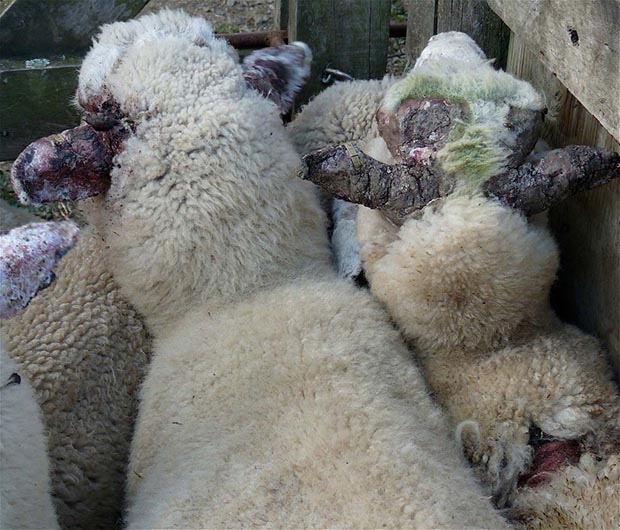
Perendale ram hoggets with clinical FE, showing skin lesions on their face and ears. These sheep did not survive, even after treatment, as their livers were too badly damaged.
THE GENETICS OF FE
Some sheep farmers started noticing that after the decimation of their flocks, there were always some sheep that survived and kept performing. Two drivers of the belief that there must be a genetic component were farm advisor (and former All Black captain) Andy Dalton and his colleague, the late Colin Southey.
They believed some stock were genetically more resistant to FE. To test this concept, Ruakura staff started by breeding a line of highly-resistant sheep, a line of low-resistant sheep, and a control line. These lines were formed by drenching sheep with the sporidesmin toxin harvested from fungi at Ruakura, then measuring the effect on the liver using a GGT test developed in human medicine to check the state of the livers of alcoholics. Spectacular progress was made in both directions of selection, proving FE resistance (or tolerance) had a clear genetic base.
This led Colin Southey to demand that toxin drenching before selecting rams was made available to farmers in his area, and flocks have now been on that programme (called Ramguard) for over 40 years, with spectacular results. Commercial farmers buy tested rams and their genes flow through the flock to spread the resistance genes. Some farmers who have specialised in testing for the longest period to guarantee their sheep have now developed the recent ‘FEGold’ brand.
Breeding cattle for FE resistance has been sadly neglected, even though research at Ruakura some years ago showed the trait in cattle was also something genetically inherited. Dairy breeding organisations have been slow to recognise that half the calves born are males reared for beef, and drenching them for FE as they grow large is a chore that beef farmers and block owners want to avoid.
THE SCIENCE OF FIGHTING FE
FE spores are easy to see down a microscope, looking like tiny brown hand grenades. Early on, staff at Ruakura developed a ‘wash method’: they would cut a sample of grass and dead litter at the pasture base, mix it with water in a jar, shake it, then count the spores from a drop of it on a special calibrated slide. This is still the way it’s done by vet clinics, and kits can be purchased for farmers to use themselves.
It’s the young, rapidly-growing spores that produce the toxin. Old dead spores that look black and solid down the microscope are harmless.
The trouble with spores is that their numbers are not consistent over a whole farm, or even in the same parts of the paddock. Counts are high in sheltered areas and on different types of slope, depending on sunshine. If you are going to count spores, then sample different areas of the farm or you risk errors by relying entirely on a general spore count.
How high is dangerous? A lot lower than you think
When spore counts are down in the low hundreds and conditions are cold, current wisdom is that there’s no problem until there’s a spike of say a million spores/g of grass. This usually occurs when rain arrives after a long dry spell in the warm humid days of late summer and early autumn.
But it’s important to realise that danger can start with a series of low counts because an animal’s liver becomes sensitised. It means when a high level of toxicity is reached, it doesn’t take a very big spore count to have a really dangerous effect, and the level of protection the animals have been given will not be enough for effective protection. It quickly becomes a crisis which needs urgent action, but by that stage it may be too late.
When to start zinc treatment
Getting minerals into the liver is like charging a battery. It takes at least three weeks after the start of zinc treatment for it to be effective, and this is always a problem for a lot of people as you need to start dosing stock on 1 January. In some places now, even this may not be early enough as FE cases are being found before Christmas.
Administering zinc is a chore that many farmers hate, but don’t delay things until you hear about spore counts rising on some other local farms.
On small blocks, to administer a bolus – your best bet – you’ll need some good yards, preferably a head bail, and you’ll need to get an experienced person to do it so that the bolus stays in the rumen and no danger is done to man and beast. That often means bringing in your vet.
When to end zinc treatment is getting trickier with cattle as long periods of zinc treatment are needed right into May as seasons stay warmer for longer. But prolonged zinc treatment is known to strip copper from the liver, so veterinary advice is needed on this one, to work out how much copper is needed. This is not an issue with sheep.
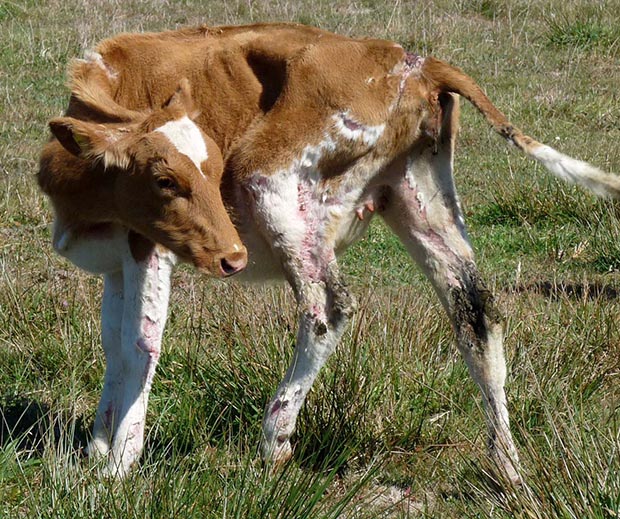
Sunburn on a calf – this animal needs to be in shade, but really needs to be euthanised as liver damage will be too serious for it to survive.
Pasture spraying
Spraying the whole farm or selected areas is still recommended, and can be an easy option. But again, knowing how effective it has been will mean you need regular spore counting to keep an eye on things, and it may not be totally effective if there is a massive spike of spores, when zinc drenching will also be needed.
Fertilisers
Fungal spores end up on and in the soil. There is advice around about how a fertiliser programme can affect spore numbers and reduce the risks of FE. Scientific opinion varies on this claim – there is no proof yet – but anecdotally, there are farmers who have applied lime and used fertilisers high in trace elements who claim not to have had FE in their stock. It is worth studying for future management to avoid all the work and cost of animal treatment.
Dealing with suffering animals
Sheep suffer more than cattle as their eyes and ears swell. They then rub them until they are red-raw, and until they cannot see. You won’t see great layers of skin come off as you do in cattle. Sunshine drives stock mad as it seems to increase the itching.
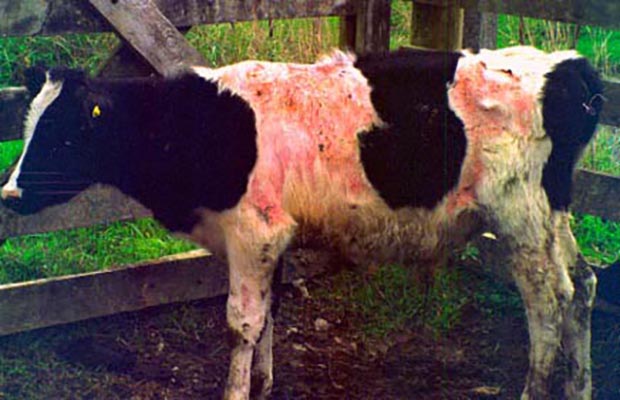
Spring Eczema
WHAT IS SPRING ECZEMA?
This is seen in cattle in spring instead of autumn. There’s still debate about its cause, but it’s assumed to be a fungal toxin or dietary problem, yet to be sorted out. Stock need the same care+ as for autumn FE.
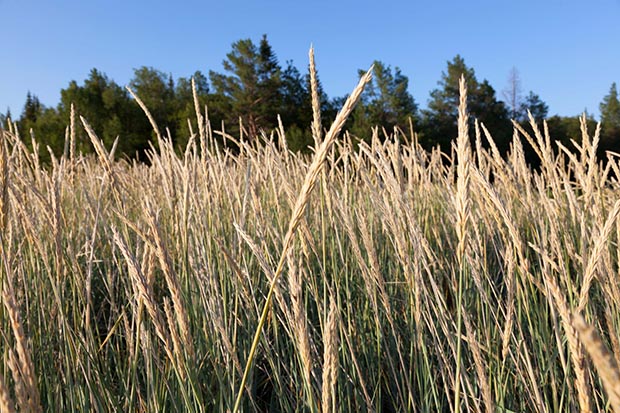
Tall fescue (Festuca arundinacea)
6 SAFER PASTURE PLANTS
FE spores prefer ryegrass. Pasture that is ryegrass-free (or a low percentage) for livestock to feed on over summer is a good management strategy. Options include:
• clover (red and white)
• chicory
• plantain
• kikuyu
• paspalum
• tall fescue
3 MYTHS ABOUT FACIAL ECZEMA
Sunburn caused by FE on animal at the sales – you cannot sell FE-affected livestock, and if you send them to the works, they will be condemned.1. Livers can recover. Livers do not recover. In sheep livers, you’ll see new round lobes but they are not fully effective and the animal is permanently damaged. The old liver will look and feel like a lump of wood.
2. Pregnant cows are ‘cured’ by their calves. A pregnant cow with FE is not able to use her calf’s liver to help her survive and become fully functional again.
3. Goats don’t get FE. They can, but it’s far less likely as they prefer to browse and don’t like to eat down low in pasture where fungal spores grow.
What to do with FE-affected stock
This can be a dilemma. Unless you get a special test done, you won’t know how badly FE has affected your stock. Research has shown that if there are 10% clinically-affected FE animals in a mob (that is, you can see symptoms like swollen eyes or flaking skin), then at least 80% will be sub-clinically affected with damaged livers and they will never be any good for breeding or long-term growth.
Putting affected stock into sale yards is against the law, and if you send them directly to the works, they will be condemned. You may be in for a surprise as any sign of jaundice – which you may not see in sheep – will cause them to be condemned too.
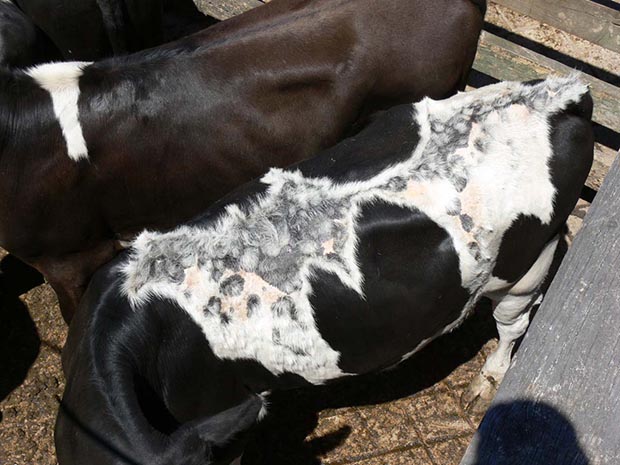
If you want to keep FE-affected stock, be prepared for deaths in spring when they lamb and calve, and when the strain of lactation hits them. Cattle are especially prone to milk fever and ewes will produce dead, often mummified lambs, even if they have large fat stores in their bodies (which they cannot use due to their damaged livers).
You’ll have to face the hard truth about getting rid of them before winter for no return, or keeping them to see how many survive. If they produce good offspring, count that as a bonus, but you’ll need to make some hard decisions. Treating them after the fact with zinc is far too late, but take veterinary advice on this for welfare reasons.
CLIVE’S ADVICE
Sheep
• Learn how to do your own spore counting.
• Start prevention in late December in FE-prone areas.
• Talk to your vet about which is the best protection method for your farm; allow a good interval between first and second bolus to avoid the risk of toxicity – it’s important to have an interval of a week or so between boluses in case two rubbing together damages the wax covering and releases a toxic dose.
• Talk to your vet before you give them a third bolus as this may risk toxicity.
• If there’s a sudden spike in spore counts, your current treatment may not be adequate so talk to your vet about action – stock may need more zinc.
• Sheep that have had severe clinical FE are best euthanased, even if they appear to have improved, as they will never be profitable.
• You won’t know which sheep have had sub-clinical FE, so talk to your vet about doing a GGT test – the bonus is you may find some that show FE resistance.
• For the future of the flock, only buy FE-tested rams – check www.sil.co.nz to find breeders as it’s money well invested, and start with the list of FEGold breeders.
• In FE-prone areas, talk to your vet but it’s best to start precautions before Christmas. Discuss what to use with your vet.
• Water trough treatment is the very last resort – a bolus is the best option.
• Affected sheep desperately need shade, so make sure this can be provided, especially during the middle of the day.
• Watch for blowfly attack on raw areas.
Cattle
• Learn how to do your own spore counting.
• Start prevention in late December in FE-prone areas.
• Talk to your vet about which is the best protection method for your farm but the only real option is zinc boluses – talk to your vet about inserting them and getting repeats but know you’ll need to get professional help to do the job and you will need a yard with a headbail.
• Allow a good interval between first and second bolus dosing to avoid the risk of toxicity.
• Talk to your vet before you give them a third bolus as this may risk toxicity.
• If there’s a sudden spike in spore counts, the treatment may not be adequate so talk to your vet about action as stock may need more zinc.
• Affected cattle desperately need shade, so make sure this can be provided, even if they have to be put into a shed during the middle of the day.
• Cattle with skin hanging off and with bare skin showing need a canvas cover and shade.
• Watch for blowfly attack on raw areas.
Love this story? Subscribe now!
 This article first appeared in NZ Lifestyle Block Magazine.
This article first appeared in NZ Lifestyle Block Magazine.
